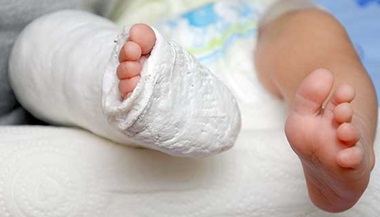Arthrogryposis
What You Need to Know
- Arthrogryposis is a term describing a number of conditions that affect the joints.
- Often times both the arms and legs are affected.
- The cause of arthrogryposis is unknown, but it almost always results from another condition.
- Arthrogryposis is typically discovered in utero or at birth.
- A medical exam and history are done to diagnose the condition. Additional genetic testing may also be performed to try and find the larger cause.
- There is no cure for the condition, but treatment options are available to alleviate its symptoms.
What is arthrogryposis?
Arthrogryposis, also called arthrogryposis multiplex congenita (AMC), is a term used to describe a variety of conditions involving multiple joint contractures (or stiffness). A contracture is a condition where the range of motion of a joint is limited. It may be unable to fully or partially extend or bend.
What are the causes of arthrogryposis?
The cause is unknown, although arthrogryposis is thought to be related to inadequate room in utero and low amniotic fluid. The patient may have an underlying neurological condition or connective tissue disorder.
What are the symptoms of arthrogryposis?
Symptoms in patients with arthrogryposis can vary greatly. In most cases, both the arms and legs are involved.
Muscle contractures of joints commonly take place in the wrist, hand, elbow and shoulder on either side of the body. Lower extremity involvement is also common involving the hips, knees and ankles. There is also muscle weakness throughout the body. Spine curvature may develop in some patients.
How is arthrogryposis diagnosed?
There is no prenatal diagnostic test for arthrogryposis. Abnormalities may be found during ultrasound, and further testing will be required to look for any underlying cause.
A full history and medical exam will be completed to comprehensively assess each patient. A diagnosis of arthrogryposis is made when a patient has two or more joint contractures found at different areas of their body. Once diagnosed, genetic testing will likely be recommended to look for a primary cause of the condition.
Treatment for Arthrogryposis
While there is no cure for arthrogryposis, there are nonoperative and operative methods aimed to improve range of motion and function at the sites of contracture.
Nonoperative Treatment
Occupational and physical therapy is the initial line of treatment to improve range of motion. Occupational therapists typically work on the upper extremities while physical therapists focus more on the lower extremities and gait. Aquatic therapy may also be recommended as an additional method to provide strengthening and range of motion exercises.
Therapy should be started in early infancy. Goals of early therapy include maximizing strength, improving range of motion and enhancing sensorimotor development. Gentle stretching exercises can help lessen the contracture and improve motion. This will allow the child to develop optimal positions for functional improvement in activities of daily living and will enhance development of motor skills. Family education is important for proper positioning, stretching techniques and avoiding potentially harmful activities that could feed into deformity. Splinting and casting can be used by therapists or providers to help with stretching and positioning as well as reducing joint contractures. Power mobility and other assistive devices may be recommended to support patients.
Surgical Treatment
Children who develop elbow, wrist and or hand flexion contractures that do not lessen with occupational and physical therapy may benefit from orthopaedic surgery to improve range of motion. Improved range of motion will help children with independent feeding, hygiene and other upper extremity physical activity.
There are also orthopaedic surgical procedures to help with lower extremity contractures in the knees and hips. These corrective surgeries can also provide improved range of motion and improved ability to bear weight and walk.
In children with severe spine curvature, bracing or orthopaedic surgery may be recommended to correct the spine deformity. This depends on many factors, such as age of the child as well as location, degree and flexibility of the curve.
Physical therapy and splinting/bracing will likely be recommended after surgery to maintain the correction from the surgery.
Arthrogryposis Clinic
The Pediatric Division of the Johns Hopkins Department of Orthopaedic Surgery has a specialty arthrogryposis clinic run by Dr. Ranjit Varghese, attending pediatric orthopaedic surgeon. Varghese has had specialized training and many years of experience treating children with arthrogryposis. Together with team members from nursing, physical therapy and occupational therapy, the clinicaims to provide the most comprehensive care for arthrogryposis patients.






